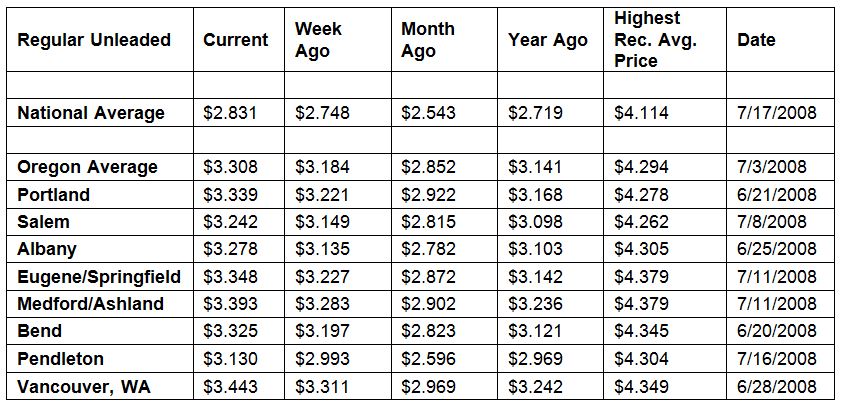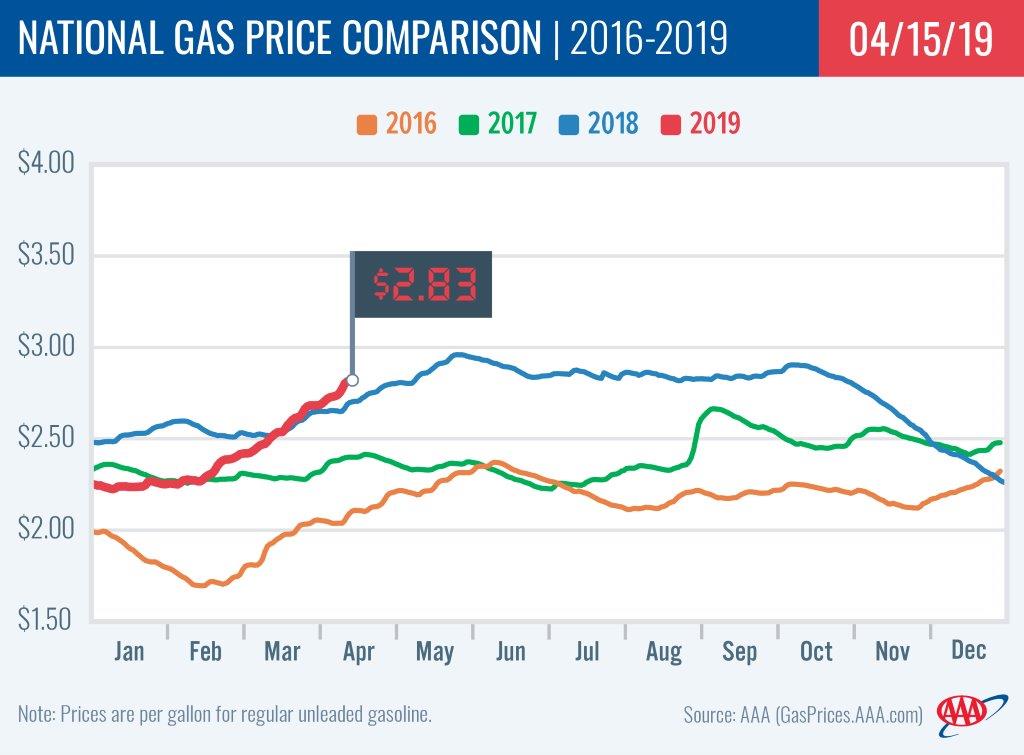Oregon has nation’s seventh-largest weekly jump and second-highest monthly increase
PORTLAND, Ore., – Retail gas prices are very expensive for this time of year due to shrinking gasoline stocks from refinery maintenance, increased demand for gas and higher crude oil prices. For the week, the national average jumps eight cents to $2.83 a gallon, its highest price since last October. The Oregon average shoots up 12 cents to $3.31. This is the seventh-largest weekly jump in the nation and also the highest price for the Oregon average since last November.
“The West Coast is especially hard hit with tightening gasoline stocks due to planned and unplanned refinery maintenance,” says Marie Dodds, public affairs director for AAA Oregon/Idaho. California’s average jumped 18 cents this week to $4.01 a gallon, the most expensive state average this week and a price point not seen in the Golden State since July 2014.
Nationwide, gasoline stocks dipped substantially by 7.7 million barrels while demand rose to summer-like highs. In addition, crude oil prices have climbed, due in part to OPEC’s 1.2 million b/d production reduction agreement which remains in place through June and the U.S. tightening of its crude export sanctions against Iran and Venezuela. Crude oil started this year around $47 per barrel and is currently trading around $63. These factors will continue to put upward pressure on retail pump prices in the coming weeks.
Prices in all 50 states and the District of Columbia are higher now than a week ago. Oregon has the seventh-largest weekly jump in the country. Utah (+19 cents), California (+18 cents) and Nevada (+18 cents) have the largest week-over-week increases while Florida (+3 cents) has the smallest. This week, California is the only state with an average at or above $4 a gallon. Hawaii, Washington, Oregon, Nevada and Alaska have averages at or above $3 a gallon.
All 50 states and the District of Columbia have higher prices now than a month ago. The national average is 29 cents more and the Oregon average is 46 cents more than a month ago. This is the second-largest monthly increase in the country. California (+67 cents) has the largest month-over-month jump while Washington (+45 cents) is third. Florida (+16 cents) has the smallest monthly increase.
Pump prices in the West Coast region are the highest in the nation, with all of the region’s states landing on the top 10 most expensive list. California tops the list for the fourth consecutive week with Hawaii, Washington, Oregon, Nevada, Alaska and Arizona rounding out the top seven. Oregon is fourth most expensive for the fifth week in a row. As mentioned above, California is the only state with an average at or above $4 a gallon.
| Rank | Region | Price on 4/16/19 | |
| 1 | California | $4.01 | |
| 2 | Hawaii | $3.58 | |
| 3 | Washington | $3.41 | |
| 4 | Oregon | $3.31 | |
| 5 | Nevada | $3.28 | |
| 6 | Alaska | $3.19 | |
| 7 | Arizona | $2.98 | |
| 8 | Pennsylvania | $2.98 | |
| 9 | Illinois | $2.94 | |
| 10 | District of Columbia | $2.92 |
The Energy Information Administration’s (EIA) recent weekly report, for the week ending on April 5, showed that West Coast gasoline stocks fell for a fourth consecutive week by nearly 2 million bbl from the previous week and now sit at 29.04 million bbl. Ongoing planned and unplanned refinery maintenance throughout the region continues to shrink stocks. Total levels are approximately 2.4 million bbl lower than this time last year and could fall further this week depending on refinery maintenance turnaround.
The nation’s cheapest markets are Alabama ($2.51) and Mississippi ($2.52). For the ninth week in a row, no states have an average below $2 a gallon.
Oregon is one of 42 states and the District of Columbia where drivers are paying more than a year ago to fill up. The national average is 11 cents more and the Oregon average is 17 cents more than a year ago, which is the sixth-largest yearly increase in the country. California (+46 cents) and Arizona (+24 cents) have the greatest year-over-year increases. Utah (-27 cents) and Idaho (-20 cents) have the largest year-over-year decreases.
Oil Market Dynamics
Crude oil prices have been climbing for four weeks. They’ll likely continue their ascent this week, as a weaker dollar helped to push crude prices up because of the increased number of dollars needed to purchase crude on the global market. Another contributing factor to the price jumps came from reports that there was a 534,000-b/d decline in crude production by OPEC members in March, led by Saudi Arabia cutting back by 324,000 b/d. The news underscores that OPEC and its partners are making reductions in service consistent with their 1.2 million b/d production reduction agreement, which is in place through June. OPEC has announced that it will not meet in April to discuss the pact; instead, it will meet on June 25 and 26 and may announce a decision to end or extend its agreement at that time.
In related news, EIA data revealed that total domestic crude inventories grew by 7 million bbl to 456.6.5 million bbl. Additionally, Baker Hughes Inc. reported that the U.S. gained two oilrigs last week, bringing the total to 833. When compared to last year at this time, there are 18 more rigs this year.
At the close of Friday’s formal trading session on the NYMEX, WTI increased 31 cents to settle at $63.89. At the close of Monday’s formal trading session on the NYMEX, WTI lost 49 cents to close at $63.40. Today crude is trading around $64, same as $64 a week ago. Crude prices are up about eight percent in the last month and are about $4 per barrel less than a year ago.
Drivers can find current gas prices along their route with the free AAA Mobile app for iPhone, iPad and Android. The app can also be used to map a route, find discounts, book a hotel and access AAA roadside assistance. Learn more at AAA.com/mobile.
Diesel
For the week, the national average adds three cents to $3.07 a gallon. Oregon’s average gains six cents to $3.22. A year ago the national average for diesel was $3.01 and the Oregon average was $3.25.
Find current fuel prices at GasPrices.AAA.com.
AAA news releases, high resolution images, broadcast-quality video, fact sheets and podcasts are available on the AAA NewsRoom at NewsRoom.AAA.com.



